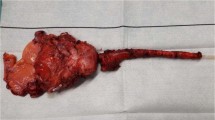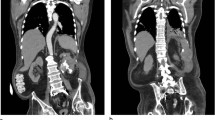Abstract
Introduction
Patients with spinal cord injury/disorder (SCI/D) and neurogenic lower urinary tract dysfunction (NLUTD) are on a 16–28 folder higher risk for bladder cancer [1]. Whereas in the general population 90% of bladder tumors are transitional cell carcinoma (TCC) patients with NLUTD have a shift to squamous cell carcinoma with 36,8% and only 46.3% TCC [2]. In addition, there is a significant increase in the bladder cancer-specific death rate in SCI patients (3rd most common) compared to the general population (10th most common) [2]. Chronic inflammation and mechanical irritation by permanent indwelling catheters are discussed as risk factors for developing bladder cancer. Typical symptoms of bladder cancer are often absent in patients with NLUTD and a reliable screening has not been established.
Case presentation
We present a case series of six patients with SCI and with squamous cell carcinoma diagnosed in the last 5 years in our institution. In five patients, bladder management was performed by indwelling suprapubic catheters, one patient used reflex voiding. Three patients were diagnosed during the regular, annual neuro-urological check-up, the remaining due to increasing spasticity and autonomic dysregulation. Subsequently, five patients underwent cystectomy with ileal conduit or uretercutaneostomy, one patient refused further surgical treatment. Four patients died within one year after diagnosis.
Discussion
Squamous cell carcinoma of the bladder is more common in patients with NLUTD. Chronic inflammation and mechanical irritation may be the reasons for carcinoma genesis. A regular check including cystoscopy is strongly recommended to detect tumor development early.
This is a preview of subscription content, access via your institution
Access options
Subscribe to this journal
Receive 1 print issues and online access
We are sorry, but there is no personal subscription option available for your country.
Buy this article
- Purchase on SpringerLink
- Instant access to full article PDF
Prices may be subject to local taxes which are calculated during checkout






Similar content being viewed by others
References
El-Ghazaly T, Ellimoottil C, Wheeler J, Bresler L. Incidentally-discovered squamous cell carcinoma after endoscopic Sphincterotomy. Curr Urol. 2015;8:166–8.
Gui-Zhong L, Li-Bo M. Bladder cancer in individuals with spinal cord injuries: a meta-analysis. Spinal Cord. 2017;55:341–5.
Panicker JN, Fowler CJ. The bare essentials: uro-neurology. Pract Neurol. 2010;10:178–85.
Sahai A, Cortes E, Seth J, Khan MS, Panicker J, Kelleher C. Neurogenic detrusor overactivity in patients with spinal cord injury: evaluation and management. Curr Urol Rep. 2011;12:404–12.
EAU Guidelines. Edn. presented at the EAU Annual Congress Milan. Milan; 2023. Verfügbar unter: http://uroweb.org/guidelines/compilations-of-all-guidelines/
Torre LA, Bray F, Siegel RL, Ferlay J, Lortet-Tieulent J, Jemal A. Global cancer statistics, 2012. CA Cancer J Clin. 2015;65:87–108.
Howlader N, Mariotto AB, Woloshin S, Schwartz LM. Providing clinicians and patients with actual prognosis: cancer in the context of competing causes of death. J Natl Cancer Inst Monogr. 2014;2014:255–64.
Pannek J. Transitional cell carcinoma in patients with spinal cord injury: a high risk malignancy? Urology. 2002;59:240–4.
Cameron AP, Rodriguez GM, Schomer KG. Systematic review of urological followup after spinal cord injury. J Urol. 2012;187:391–7.
Pannek J, Rademacher F, Wöllner J. Clinical usefulness of urine cytology in the detection of bladder tumors in patients with neurogenic lower urinary tract dysfunction. Res Rep Urol. 2017;9:219–23.
Friedrich V, Choi HW. The urinary microbiome: role in bladder cancer and treatment. Diagn Basel Switz. 2022;12:2068. 26.
Delnay KM, Stonehill WH, Goldman H, Jukkola AF, Dmochowski RR. Bladder histological changes associated with chronic indwelling urinary catheter. J Urol. 1999;161:1106–8.
Kalisvaart JF, Katsumi HK, Ronningen LD, Hovey RM. Bladder cancer in spinal cord injury patients. Spinal Cord. 2010;48:257–61.
Stonehill WH, Goldman HB, Dmochowski RR. The use of urine cytology for diagnosing bladder cancer in spinal cord injured patients. J Urol. 1997;157:2112–4.
Veeratterapillay R, Gravestock P, Nambiar A, Gupta A, Aboumarzouk O, Rai B. Time to turn on the blue lights: A systematic review and meta-analysis of photodynamic diagnosis for bladder cancer. Eur Urol Open Sci. 2021;31:17–27.
Ng K, Stenzl A, Sharma A, Vasdev N. Urinary biomarkers in bladder cancer: A review of the current landscape and future directions. Urol Oncol. 2021;39:41–51.
Welk B. The argument against screening for bladder cancer in neuro-urological patients. World J Urol. 2022;40:1915–9.
Locke JR, Hill DE, Walzer Y. Incidence of squamous cell carcinoma in patients with long-term catheter drainage. J Urol. 1985;133:1034–5.
Author information
Authors and Affiliations
Contributions
PL: Data collecting and analysis, write the Manuscript. JJ: Provision of histopathological images and description of the findings in them. JP: Advice and helped write the manuscript. JW: Helped write the manuscript.
Corresponding author
Ethics declarations
Competing interests
The authors declare no competing interests.
Informed consent
Written informed consent was obtained from all subjects described in the publication.
Additional information
Publisher’s note Springer Nature remains neutral with regard to jurisdictional claims in published maps and institutional affiliations.
Rights and permissions
Springer Nature or its licensor (e.g. a society or other partner) holds exclusive rights to this article under a publishing agreement with the author(s) or other rightsholder(s); author self-archiving of the accepted manuscript version of this article is solely governed by the terms of such publishing agreement and applicable law.
About this article
Cite this article
Levien, P., Pannek, J., Janzen, J. et al. Squamous cell carcinoma of the urinary bladder in patients with chronic spinal cord injury: A case series. Spinal Cord Ser Cases 10, 67 (2024). https://doi.org/10.1038/s41394-024-00680-z
Received:
Revised:
Accepted:
Published:
DOI: https://doi.org/10.1038/s41394-024-00680-z
This article is cited by
-
Managing Neurogenic Bladder with a Suprapubic Catheter vs Urethral Foley – Which is Best?
Current Bladder Dysfunction Reports (2025)



